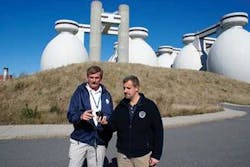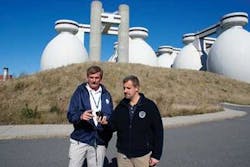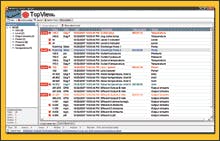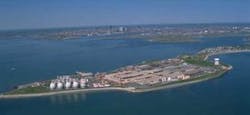The Massachusetts Water Resources Authority (MWRA), which operates the nation’s second largest wastewater treatment facility at Deer Island in Boston Harbor, relies on an easy-to-use monitoring and alarm notification software program to help keep processes running efficiently and safely.
“The Deer Island plant is one of the most highly automated, technically advanced wastewater treatment plants in the nation,” said David Duest, Deer Island Treatment Plant (DITP) Manager, Process Control. “To best leverage our assets, operate cost effectively, and help improve communication within our organization, we need an alarm notification application that is robust, simple to configure, and has the capability to help us easily tweak measurement values to reduce false alarms.”
The scope and sophistication of the Deer Island facility is impressive. It treats an average of 365 mgd with a peak capacity of up to 1.3 billion gallons per day.
More than 250 dry tons of solids per day are removed from the wastewater during the treatment process, leaving an effluent that is fully compliant with the U.S. Clean Water Act. Treated effluent is discharged 9.5 miles offshore into Massachusetts Bay in ocean waters more than 100 feet deep. Removed solids are further treated and converted into a fertilizer pellet for beneficial re-use. Gas generated from the solids treatment process is burned on-site in boilers to meet the plant’s heating requirements. Electricity generated from the excess heat is used to offset purchased power requirements.
The overall goals of the facility are to provide safe, reliable sewer services to its member communities in a cost-effective manner while protecting the environment and public health.
Alarm Monitoring
Keeping such an extensive facility and its many complex processes working smoothly is not an easy task. It requires an extraordinary amount of diligence and attention to detail.
One of the tools that Duest and his staff depend on heavily is software that gives them the ability to automatically monitor and deliver alarms related to vital measurements throughout the facility and important remote locations without the need for control room supervision or intervention. If a piece of equipment is experiencing a problem, the alarm software can provide alarms and messages directly to designated personnel without going through the control room first.
“In order to help improve overall plant performance, we want all relevant staff, operations, maintenance, laboratory, and management personnel to see critical issues as they are developing prior to them becoming major problems,” Duest said.
More than two years ago, MWRA took a close look at its existing alarm software and staff decided they needed a program that was more reliable, robust, stable, and easy to configure and adjust. They wanted software that could provide an array of alarm-notification choices, including e-mail, cell phone text and pager alerts, smart device messages, and more.
An extensive review of available options was conducted by John Baranowsky, DITP Process Control Project Manager; Michael Farmer, MWRA MIS Program Manager, Technical Services; and Duest. They looked at and tested several options and evaluated the software related to the products’ ease of installation, configurability, and stability. They performed side-by-side comparisons with their existing notification software to validate product claims and capabilities.
After the evaluation, they selected Exele TopView® monitoring, notification, and alarm software. It runs on a PC connected to the MWRA network and PI servers, and functions independently of the DCS, so that alarms and messages are distributed automatically to user-configured queues of designated personnel without the need for attention by control room personnel.
How It Works
The software can be installed on a PC or laptop connected to a plant’s Distributed Control System (DCS), SCADA, PLC, or PI server. TopView’s screens allow users to input specific setpoint values for equipment on the network. After setting measurement values for each desired tag, the names and contact information are input for personnel who need to receive an alarm when an out-of-norm condition occurs. Alarms can be sent automatically as e-mails, cell phone messages, pager notices, text-to-speech voice annunciation, audible alarms over speakers, and text messages. TopView also allows remote monitoring by staff members using a cell phone, computer, standard phone, or hand-held smart device.
In addition to the basic set up for each tag value, the software allows use of time delay and time average values without the need to create new tags. And, users can set up multiple conditions, create custom alarm messages with real-time data and add instructions to operators that could be useful in locating and diagnosing specific problems.
“This can give operators insights about the tools or equipment they might need to bring with them to fix a problem, “ Baranowsky said. “ In addition, e-mail alarm groups can be set up to make sure that everyone is kept in the loop when a specific type of a problem occurs. Such groups might include compliance personnel, management, as well as operators and maintenance staff. You can even set up a cascading queue of alarm recipients, so that if one person doesn’t respond, the next person on the list gets the alert.”
Functionality, Benefits
“The most obvious benefit of TopView for us is that it directly informs relevant staff members about potential operational issues before they become major problems,” Duest said.
“We use TopView to monitor high-priority measurements. Even though DITP’s DCS monitors more than 35,000 points and about 11,000 of these points are tracked in our PI data archive, we use TopView software to constantly monitor about 400 of the highest-level, critical points throughout the facility. So, if a problem occurs at any one of those 400 points, staff members are alerted immediately.
“The efficiency of our monitoring and notification program plays an important role in helping us maintain a superior record for public health and regulatory compliance. For example, we continuously monitor the health of pumping operations, secondary treatment, disinfection and dechlorination processes, as well as emissions,” Duest said.
The system also helps MWRA protect important infrastructure assets. The software constantly monitors chemical tank levels to ensure that there are no leaks to containment vessels or to the environment.
“We constantly monitor vibration and temperature on high-speed rotary equipment, including pumps and motors. If these values were to be out of range and if attention wasn’t paid to the problem quickly, the equipment could fail catastrophically and possibly cause significant damage. At a minimum, TopView alerts operators to shut down the equipment quickly before damage occurs,” Duest said.
“Another important aspect of our monitoring and alarm capability relates to more cost-effective plant operation. For example, we use digester gas to generate electricity. TopView helps us maximize the digester gas operation. In fact, MWRA estimates that it typically saves over $15 million per year because of efficient Digas utilization.
“We also have TopView continuously monitor real-time electricity pricing that we collect from a Web site that lists spot market price quotes every five minutes. When the wholesale electricity price reaches our threshold price, the software sends us an alert so we can make the decision to self-generate power rather than buy it from the grid,” Duest said.
Deer Island staff also uses the software to keep the DCS and PI system functioning smoothly. Its monitoring/alarming capabilities are used to pinpoint and track points of failure in the system for short-term troubleshooting and long-term stability.
Tweaking Nuisance Alarms
Duest and Baranowsky pointed out that nuisance alarms are major problems with any alarm application. If there are too many false alarms, staff confidence can become eroded, thus reducing the effectiveness of the program.
Many alarm applications only evaluate one or two conditions relative to a triggered value. TopView allows users to create simple and/or advanced alarm rules to better evaluate operating conditions as they relate to plant objectives. For example, several conditions can be evaluated over ‘X’ period of time to ensure a condition is truly an ‘Alarm’ condition. This feature significantly improves alarm accuracy and efficiency.
“We can establish preset values for suspect measurements and customize a message to say, ‘Investigate.’ After such an alarm event and subsequent investigation, TopView gives us the ability to easily change the limit making it more or less sensitive to triggering the alarm,” Duest said.






